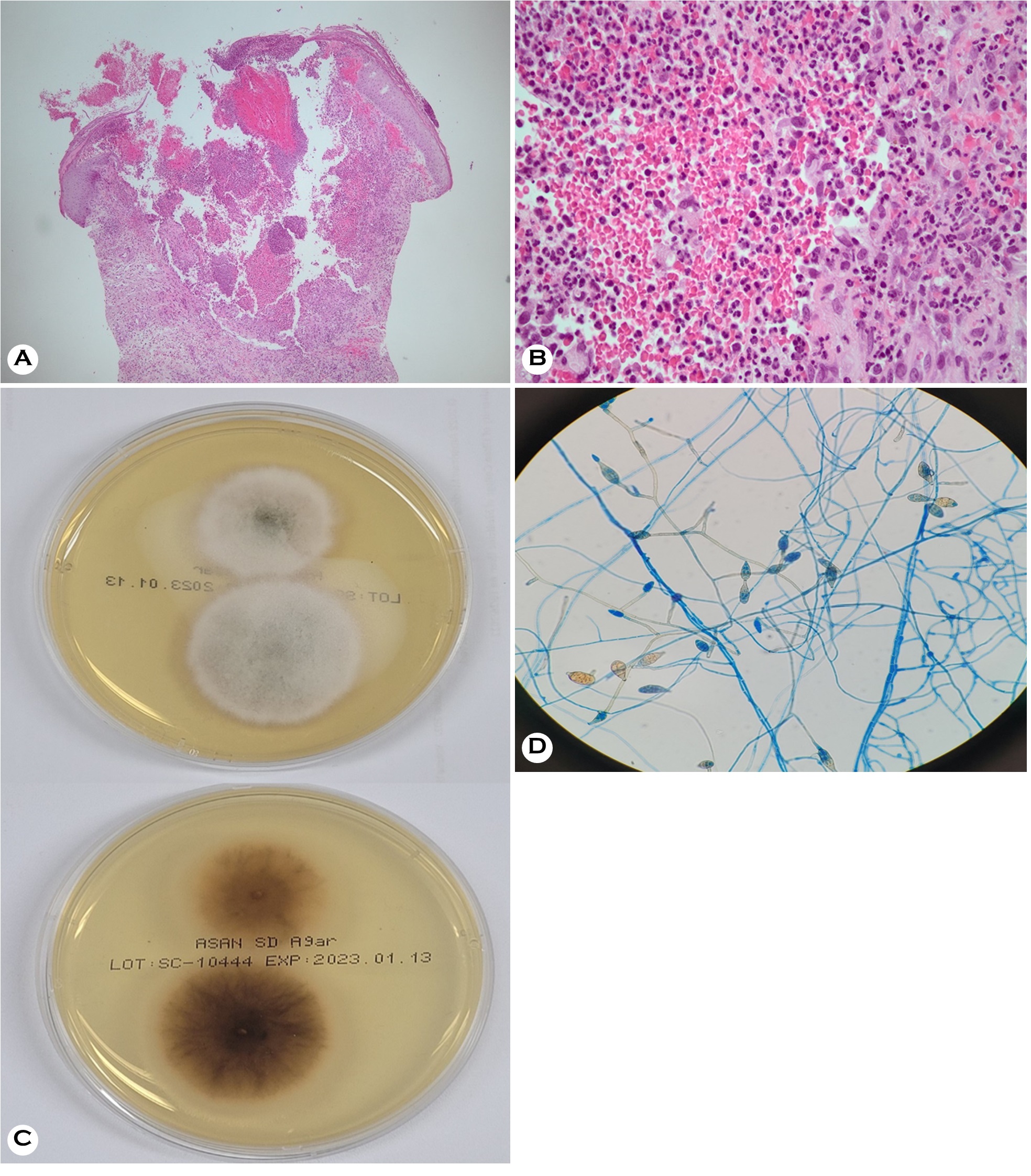pISSN : 3058-423X eISSN: 3058-4302
Open Access, Peer-reviewed

pISSN : 3058-423X eISSN: 3058-4302
Open Access, Peer-reviewed
Chan Hui Jang,Doo Rae Cha,Jin Soo Kim,Do Won Kim,Ho Seok Suh
10.17966/JMI.2024.29.1.36 Epub 2024 March 28
Abstract
Keywords
Alternariosis Itraconazole Topical corticosteroids
An 80-year-old woman presented with a 6-month history of bilateral painful erythematous exudative patches with pustules on her lower legs. The patient is a farmer who had no relevant medical or trauma history. Under the clinical impression of chronic pruritus without primary skin lesions, topical corticosteroids were administered to the lower legs for several years; however, no improvement was observed, and new lesions gradually emerged.
Physical examination revealed painful bilateral erythematous exudative patches studded with multiple pustules and black grains on the lower limbs (Fig. 1A, B). Laboratory examin- ations revealed a high C-reactive protein level (2.48 mg/ dL), and no other specific findings were observed. Histopath- ological examination revealed epidermal necrosis, abscess formation within the epidermis and dermis, and densely mixed inflammatory cell infiltration with lymphoplasmacytic cells and neutrophils in the dermis (Fig. 2A, B). Periodic acid-Schiff staining was negative. Tissue cultures for bacteria and mycobacteria were also negative. However, fungal cultures showed cotton-like gray-white colonies with a dark-brown underside, and lactophenol cotton blue staining confirmed septate hyphae and long chains of rounded conidia (Fig. 2C, D). Species were identified by matrix-assisted laser desorption /ionization time-of-flight mass spectrometry (Microflex LT, Bruker Daltonics, Bremen, Germany). The patient was diag- nosed with cutaneous alternariosis caused by Alternaria alternata and received oral itraconazole treatment, which led to clinical improvement.
Alternaria, a pigmented filamentous fungus, is widely dis- tributed in nature1. Alternaria includes various species such as A. alternata, A. infectoria, A. tenuissima, A. alternatum, and A. tenuis2, which can be identified using molecular biology methods1,2. Alternaria grows relatively rapidly and mature in 5 days. Alternaria usually does not cause infection in patients with immunocompetent status3. Risk factors for alternariosis include trauma, long-term use of systemic corticosteroids, Cushing's syndrome, and immunocompromised status2,4. Alternaria infection along the aerosol route was reported in patients with immunocompetent status and a history of using intranasal corticosteroid spray5. Similarly, Machet et al.4 reported cutaneous alternariosis associated with topical corticosteroids and proposed that cutaneous fragility induced by topical corticosteroids increases the possibility of per- cutaneous inoculation of Alternaria from the environment. Clinical manifestations of cutaneous alternariosis mainly occur on the lower extremities and may present as localized, painful, and erythematous scaly papules, plaques, or nodules1. These lesions can progress to crust, erosions, or ulcerations3. Alternariosis is diagnosed by histopathological and mycol- ogical analyses of a skin biopsy. Histopathological obser- vations revealed epidermal hyperplasia with intraepidermal abscesses and a dense inflammatory cell infiltrate with fungal elements in the dermis. Mycological culture tests revealed white brown mold colonies composed of septate hyphae and chains of conidia with transverse and longitudinal septations. Cutaneous alternariosis usually has a good prognosis with appropriate treatment2. Treatment options include topical or systemic antifungal agents, and surgical resection can be considered if necessary3. In this case, the clinical features improved after oral administration of 100 mg itraconazole twice daily for 20 weeks.
Healthy older adults with prolonged use of topical steroids may have an increased risk of fungal infections4. In addition, even if the patient had no history of skin disease, severe itching may have resulted in chronic irritation or trauma to the skin, which can be a risk factor for fungal infections. To our knowledge, this is the first report of bilateral cutaneous alternariosis in a patient with an immunocompetent status with no history of skin diseases or long-term steroid use. Therefore, if pruritic or eczematous lesions do not respond to appropriate treatment, a skin biopsy may be necessary to confirm the diagnosis. If symptoms change from pruritus to pain, the possibility of cutaneous infection, including bacterial or fungal infection, should be considered.


References
1. Colosi IA, Crisan M, Toc DA, Colosi HA, Georgiu C, Sabou M, et al. First reported case of a clinically nonresponsive-to-itraconazole Alternaria alternata isolated from a skin infection of a nonimmunocompromised patient from Romania. J Fungi (Basel) 2023;9:839
Google Scholar
2. Jebari M, Mtibaa L, Abid R, Hannechi S, Souid H, Battikh R, et al. Unusual location of cutaneous alternariosis in an immunocompetent patient. IDCases 2021;27:e01356
Google Scholar
3. Yasui M, Hattori M, Ikegami N, Kaga M, Ogawa Y, Hiruma M. A case of alternariosis successfully treated with local hyperthermia. Mycoses 2011;54:e623-626
Google Scholar
4. Machet L, Jan V, Machet MC, Vaillant L, Lorette G. Cutaneous alternariosis: Role of corticosteroid-induced cutaneous fragility. Dermatology 1996;193:342-344
Google Scholar
5. Chang GH, Wang WH. Intranasal fungal (Alternaria) in- fection related to nasal steroid spray. Am J Otolaryngol 2013;34:743-745
Google Scholar
Congratulatory MessageClick here!